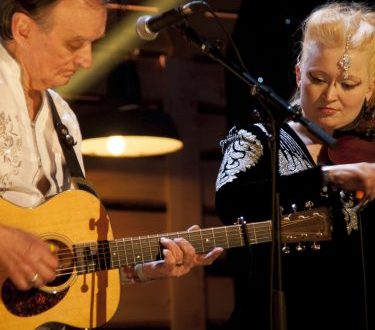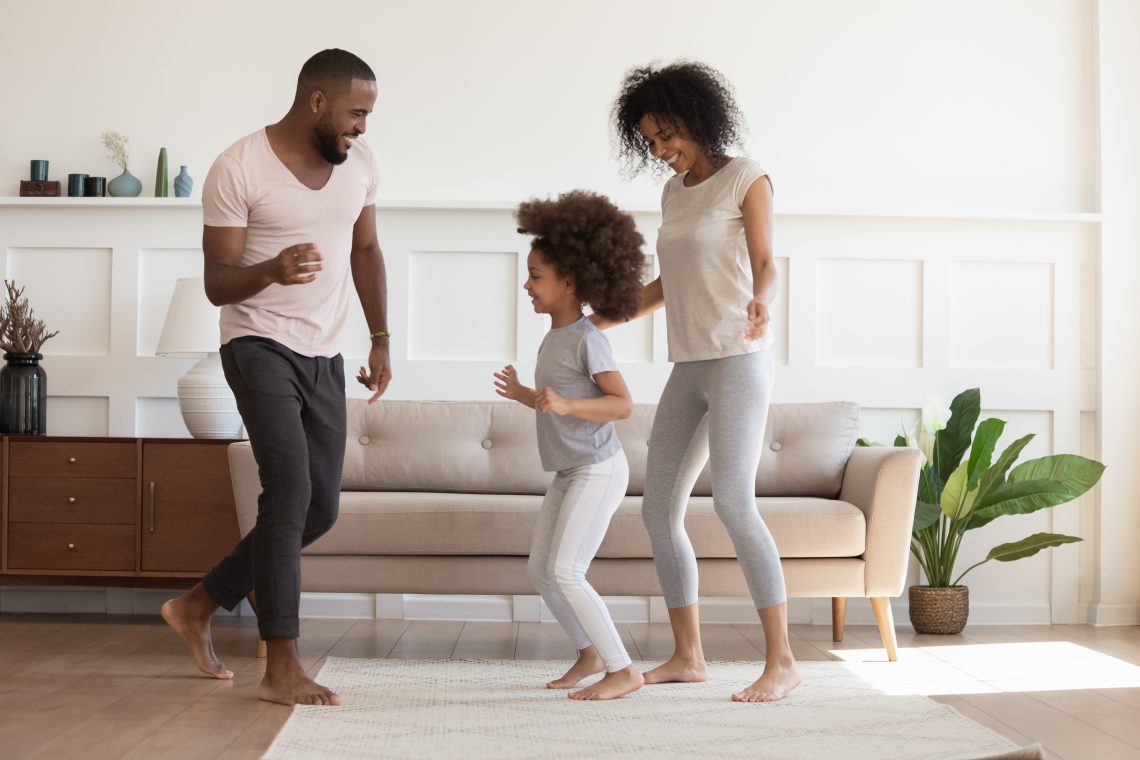
How to develop a sense of rhythm in children and adults?
First of all, you need to understand that it is impossible to develop a sense of musical rhythm in isolation from practice. In other words, you need to develop it in the process of music lessons with the help of special exercises and techniques, which we will discuss below.
Another thing is that there are also such activities that contribute, that is, can help develop a sense of rhythm, despite the fact that they are not directly related to musical practice. We will also consider them separately.
Developing a sense of rhythm in music lessons
A variety of types of musical activity can be directed to educating a sense of rhythm: studying the theoretical base, playing an instrument and singing, rewriting notes, conducting, etc. Let’s consider the main methods that are devoted to this problem.
CASE №1 “EDUCATION OF THE BRAIN”. The sense of rhythm is not just a feeling, it is also a certain way of thinking. Therefore, it is extremely important to gradually bring the child (and the adult – to come himself) to the awareness of the phenomena of rhythm from the point of view of musical theory. What is the most important thing here? The concepts of pulse, meter, musical signature, knowledge of the duration of notes and pauses are important. The following materials will help you in completing this task (click on the names – new pages will open):
NOTE DURATION
PAUSE DURATION
PULSE AND METER
MUSICAL SIZE
SIGNS THAT INCREASE THE DURATION OF NOTES AND PAUSES
CASE №2 “COUNT ALOUD”. This method is widely used by teachers of music schools, both at the initial stage and with older children. What is the essence of the method?
The student aloud counts the beats in a measure in accordance with the size. If the size is 2/4, then the count goes like this: “one-and-two-and.” If the size is 3/4, then, accordingly, you need to count up to three: “one-and, two-and, three-and.” If the time signature is set to 4/4, then we count to four: “one-and, two-and, three-and, four-and”.
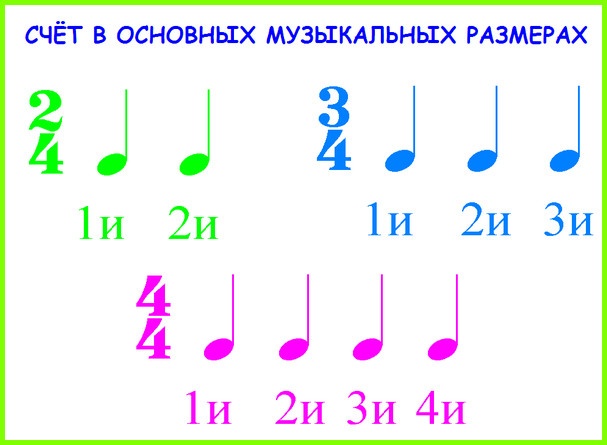
At the same time, different musical durations and pauses are calculated in the same way. A whole is counted as four, a half note or a pause takes two beats, a quarter note takes one, an eighth takes half a beat (that is, two of them can be played on a beat: one is played, for example, on “one”, and the second on “and”) .
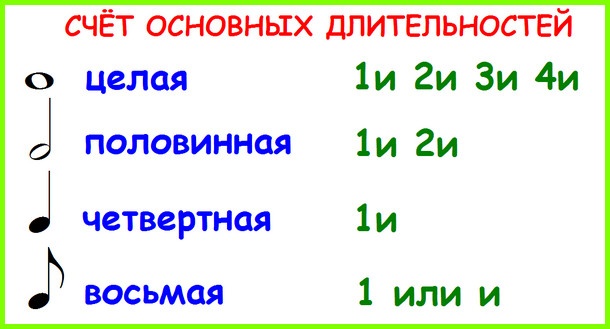
And thus, a uniform dimensional count and a count of durations are combined. If you regularly and efficiently use this method when learning pieces, then the student will gradually get used to rhythmic playing. Here is an example of such a combination:

WORK №3 «RHYTHMOSLOGY». This way of developing rhythmic feeling is very effective, it is usually used in 1-2 grades in solfeggio lessons, but you can do it at home at any age. They explain to the children that there are long and short sounds in the melody, for which rhythmic syllables of similar duration are selected.
For example, whenever a quarter note comes across in the notes, it is proposed to say the syllable “ta”, when the eighth is the syllable “ti”, two eighths in a row – “ti-ti”. Half note – we say the stretched syllable “ta-am” (as if showing that the note is long and consists of two quarters). It is very comfortable!
How to work with it? We take some melody, for example, the melody of the famous song by M. Karasev “It’s cold in winter for a little Christmas tree.” You can take an example and it is simpler or more complicated, as you like. And then the work is built in this order:
- First, we simply consider the musical text, determine what note durations it has. We rehearse – we call all the durations our “syllables”: quarters – “ta”, eighths – “ti”, half – “ta-am”.
What do we get? First measure: ta, ti-ti. Second measure: ta, ti-ti. Third: ti-ti, ti-ti. Fourth: ta-am. Let’s analyze the melody in this way to the end.
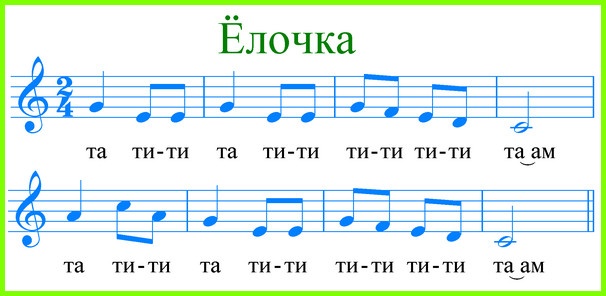
- The next step is to connect the palms! Our palms will clap a rhythmic pattern while simultaneously pronouncing rhythmic syllables. You can, of course, start right away from this stage, especially if you have resorted to the method for the first time.
- If the child has memorized the rhythmic pattern, then you can do this: replace the rhythmic syllables with the names of the notes, and let the palms continue to tap the rhythm. That is, we clap and call the notes in the right rhythm. At the same time, we are pumping, thus, both the skill of reading notes and a sense of rhythm.
- We do everything the same, only the notes are no longer just called, but sung. Let the teacher or an adult play the melody. If you are studying on your own, then listen to it in the audio recording (player – below), you can sing along with listening.
- After such a good study, it is usually not difficult for a child to approach the instrument and play the same melody with a good rhythm.
By the way, if you wish, you can use any other suitable rhythmic syllables. For example, these can be clock sounds: “tic-tac” (two eighth notes), “tiki-taki” (four sixteenth notes), “bom” (quarters or half), etc.
CASE #4 «CONDUCTING». Conducting is convenient to use when singing melodies; in this case, it replaces the account aloud. But the conductor’s gesture has one more advantage over other methods of rhythm development: it is associated with plasticity, with movement. And that is why conducting is extremely useful not only for those who sing, but also for those who play any instrument, because it brings up the accuracy of movement and will.
Indeed, it often happens that a child understands the rhythm with his hearing, and with his mind, and with his eyes, but he cannot play correctly due to the fact that coordination between hearing and action (hand movements when playing an instrument) has not been worked out. This shortcoming is just easily corrected with the help of conducting.
MORE ABOUT CONDUCTING – READ HERE
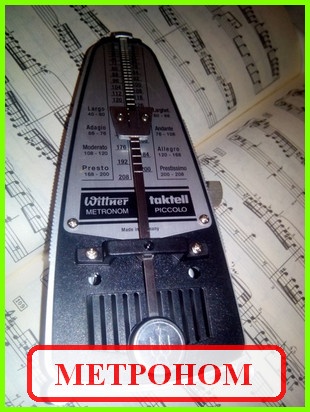 CASE №5 “METRONOME”. A metronome is a special device that beats the musical pulse at a selected tempo. Metronomes are different: the best and most expensive are the old mechanical clockwork with a scale and weight. There are analogues – electric metronomes or digital ones (in the form of an application for a smartphone or a program for a computer).
CASE №5 “METRONOME”. A metronome is a special device that beats the musical pulse at a selected tempo. Metronomes are different: the best and most expensive are the old mechanical clockwork with a scale and weight. There are analogues – electric metronomes or digital ones (in the form of an application for a smartphone or a program for a computer).
The metronome is used at different stages of learning, but mainly in work with older children and students. What is the purpose? The metronome is turned on so that the student can better hear the pulse beat, which allows him to play all the time at the same pace: neither speed it up nor slow it down.
It is especially bad when the student speeds up the pace (without a metronome, he may not feel this). Why is that bad? Because in this case, he does not play out certain beats, does not withstand a pause, does not win some rhythmic figures, eats them, crumple (especially sixteenth notes on the last beats of the bar).
As a result, the work is not only rhythmically distorted, but the quality of its performance also suffers – sooner or later, acceleration leads to the fact that the work “talks out”, clarity is lost in it, and technical errors appear (stops, passages fail, etc.) . All this happens because, when accelerating, the musician does not allow himself to breathe normally, he tenses up, his hands also tense up unnecessarily, which leads to breakdowns.
CASE No. 6 “SUBSTITUTION”. Learning melodies with text or choosing words, lyrics to music is also a good way to develop rhythmic playing. The rhythmic feeling here develops due to the expressiveness of the verbal text, which also has a rhythm. Moreover, the rhythm of words is more familiar to people than the rhythm of music.
How to apply this method? Usually in songs, stops on long notes occur at the same moments when such stops occur in the text. There are two ways, either one is effective:
- Learn a song with words before playing it on the piano (that is, feel the rhythm earlier).
- Parse the song by notes, and then for greater rhythm accuracy – play it and sing with words (words help straighten the rhythm).
In addition, subtext often helps to master some complex rhythmic figures, such as quintuplets. More details about the performance of fifths and other unusual rhythms can be found in the article devoted to the types of rhythmic division.
TYPES OF RHYTHMIC DIVISION – READ HERE
Activities to develop a sense of rhythm
As we noted above, if such activities that do not directly relate to music, but help children and adults in educating a sense of rhythm. Such activities include mathematics, poetry reading, physical exercises, choreography. Let’s take a closer look at what we have mentioned.
MATHEMATICS. Mathematics, as you know, helps the development of logical thinking. Even the simplest arithmetic operations that are practiced by children in grades 1-2 significantly increase the sense of proportion and symmetry. And we have already said that these feelings help to assimilate the rhythm with the mind.
Let me make one recommendation. If you are testing the sense of rhythm in your young son or daughter, and the results are not very encouraging, then there is no need to urgently drag them to a music school. It is necessary that they grow up a little, learn to read, write, add and subtract at school, and only after that, that is, at the age of 8-9, already bring the child to a music school. The fact is that a weak sense of rhythm is most effectively developed mentally, and therefore success requires at least elementary mathematical training.
READING OF POEMS. Expressive reading of poems is useful not only because it is also associated with the reproduction of rhythms, albeit speech ones. Music is also, in a certain sense, speech and language. The analysis of the content of poetic texts is of great benefit.
After all, how do most people read poetry? They pick up the rhymes, but they don’t understand what they are reading at all. Once we happened to attend a literature lesson in the 8th grade. Passed the poem “Mtsyri” by M.Yu. Lermontov, the children recited excerpts from the poem by heart. It was a sad picture! The students pronounced the text clearly line by line, completely ignoring the punctuation marks (periods and commas) that could occur in the middle of the line, and completely ignoring the fact that there might not be any punctuation marks at the end of the line.
Let’s take a look at one of the passages. Here is what Lermontov wrote in meaning (not line by line):
Holding a pitcher over your head The Georgian went down a narrow path to the shore. Sometimes she slipped between the stones, Laughing at their awkwardness. And her outfit was poor; And she walked easily Back bends long veils thrown back. The summer heat cast a shadow over her golden face and chest; And heat breathed from her lips and cheeks.
Now compare this content with the one that was pronounced by the reading students line by line (several examples):
“Went down to the beach. Sometimes ”(And sometimes she didn’t go?) “And she walked easily, back” (The girl turned on the reverse gear, like in a car) “Throwing away. Summer heats ”(She threw the heat away, long live the cold!)
Does the text of master storytellers differ from the text of Lermontov? The question is rhetorical. That is why it is important to analyze the content. This helps to analyze the music later in terms of its rhythmic structure, phrasing, and not to play something vice versa.
PHYSICAL EDUCATION AND DANCES. These methods allow you to learn the rhythm with the help of plasticity, movements. If we are talking about physical education, then here, first of all, we should keep in mind the warm-up exercise, which is usually carried out in schools with a good rhythmic score. For the development of rhythm, tennis (rhythmic responses) and rhythmic gymnastics (to music) can also be useful.
Nothing to say about dancing. First, the dance is almost always accompanied by music, which the dancer also memorizes rhythmically. And, secondly, many dance movements are learned to the musical score.



